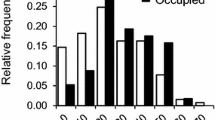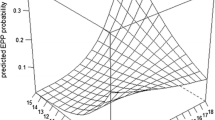Abstract
Sex allocation theory predicts that if variance in reproductive success differs between the sexes, females who are able to produce high-quality young should bias offspring sex ratio towards the sex with the higher potential reproductive success. We tested the hypothesis that high-quality (i.e., heavy) female eastern kingbirds (Tyrannus tyrannus) that bred early in the breeding season would produce male-biased clutches. A significant opportunity for sexual selection also exists in this socially monogamous but cryptically polygamous species, and we predicted that successful extra-pair (EP) sires would be associated with an excess of male offspring. Although population brood sex ratio did not differ from parity, it increased significantly with female body mass and declined with female breeding date, but was independent of the morphology and display (song) behavior (correlates of reproductive success) of social males and EP sires. Male offspring were significantly heavier than female offspring at fledging. Moreover, the probability that male offspring were resighted in subsequent years declined with breeding date, and was greater in replacement clutches, but lower when clutch size was large. Probability of resighting female offspring varied annually, but was independent of all other variables. Given that variance in reproductive success of male kingbirds is much greater than that of females, and that male offspring are more expensive to produce and have a higher probability of recruitment if fledged early in the season, our results support predictions of sex allocation theory: high-quality (heavy) females breeding when conditions were optimal for male recruitment produced an excess of sons.

Similar content being viewed by others
References
Abroe B, Garvin J, Pedersen M, Whittingham LA, Dunn PO (2007) Brood sex ratios are related to male size, but not attractiveness in the common yellowthroat. Auk 124:176–184
Andersson M (1994) Sexual selection. Princeton University Press, Princeton, NJ
Appleby BM, Petty SJ, Blakey JK, Rainey P, MacDonald DW (1997) Does variation of sex ratio enhance reproductive success of offspring in tawny owls (Strix aluco)? Proc R Soc Lond B 264:1111–1116
Blancher PJ, Robertson RJ (1987) Effect of food supply on the breeding biology of western kingbirds. Ecology 68:723–732
Bradbury RR, Blakey JK (1998) Diet, maternal condition, and offspring sex ratio the zebra finch, Poephila guttata. Proc R Soc Lond B 265(1399):895–899
Brown CR, Bomberger Brown M (1996) Coloniality in the cliff swallow: the effect of group size on social behavior. University of Chicago Press, Chicago
Cooper NW (2008) Life history evolution in the Eastern Kingbird: Age at first reproduction and spring arrival date. Unpubl. MS Thesis, Portland State University, Portland, OR
Cooper NW, Murphy MT, Redmond LJ, Dolan AC (2009a) Density-dependent age at first reproduction in the eastern kingbird. Oikos 118:413–419
Cooper NW, Murphy MT, Redmond LJ (2009b) Age- and sex-dependent arrival date in the eastern kingbird. J Field Orn 80:35–41
Cordero PJ, Vinuela J, Aparicio JM, Veiga JP (2001) Seasonal variation in sex ratio and sexual egg dimorphism favouring daughters in first clutches of the spotless starling. J Evol Biol 14:829–834
Daan S, Dijkstra C, Weissing FJ (1996) An evolutionary explanation for seasonal trends in avian sex ratios. Behav Ecol 7:426–430
Delhey K, Peters A, Johnsen A, Kempenaers B (2007) Brood sex ratio and male UV ornamentaion in blue tits (Cyanistes caeruleus): correlational evidence and an experimental test. Behav Ecol Sociobiol 61:853–862
Dreiss A, Richard M, Moyen F, White J, Møller AP, Danchind E (2006) Sex ratio and male sexual characters in a population of blue tits, Parus caeruleus. Behav Ecol 17(1):13–19
Dolan AC, Murphy MT, Redmond LJ, Sexton K, Duffield D (2007) Extrapair paternity and the opportunity for sexual selection in a socially monogamous passerine. Behav Ecol 18:985–993
Drilling NE, Thompson CF (1988) Natal and breeding dispersal in House Wrens (Troglodytes aedon). Auk 105:480–491
Dzus EH, Bortolotti GR, Gerrard JM (1996) Does sex-biased hatching order in bald eagles vary with food resources? Ecoscience 3:252–258
Ellegren H, Gustafsson L, Sheldon BC (1996) Sex ratio adjustment in relation to paternal attractiveness in a wild bird population. Proc Natl Acad Sci U S A 93:11723–11728
Forstmeier W, Kempenaers B, Meyer A, Leisler B (2002) A novel song parameter correlates with extra-pair paternity and reflects male longevity. Proc R Soc Lond B 269:1479–1485
Fridolfsson AK, Ellegren H (1999) A simple and universal method for molecular sexing of non-ratite birds. J Avian Biol 30:116–121
Genovart M, Jover L, Ruiz X, Oro D (2003) Offspring sex ratios in subcolonies of Audouin’s gull, Larus audouinii, with differential breeding performance. Can J Zool 81:905–910
Griffith SC, Örnborg J, Russell AF, Andersson S, Sheldon BC (2003) Correlations between ultraviolet coloration, over-winter survival and offspring sex ratio in the blue tit. J Evol Biol 16:1045–1054
Griffith SC, Owens IPF, Thuman KA (2002) Extra pair paternity in birds: a review of interspecific variation and adaptive function. Mol Ecol 11:2195–2212
Grindstaff JL, Buerkle CA, Casto JM, Nolan V Jr, Ketterson ED (2001) Offspring sex ratio is unrelated to male attractiveness in dark-eyed juncos (Junco hyemalis). Behav Ecol Sociobiol 50:312–316
Hipkiss T, Hornfeldt B (2004) High interannual variation in the hatching sex ratio of Tengmalm's owl broods during a vole cycle. Popul Ecol 46:263–268
Hornfeldt B, Hipkiss T, Fridolfsson AK, Eklund U, Ellegren H (2000) Sex ratio and fledging success of supplementary-fed Tengmalm's owl broods. Mol Ecol 9:187–192
Kempenaers B, Verheyen GR, Dhondt AA (1997) Extrapair paternity in the blue tit (Parus caeruleus): female choice, male characteristics, and offspring quality. Behav Ecol 8:481–492
Komdeur J, Magrath MJL, Krackow S (2002) Pre-ovulation control of hatchling sex ratio in the Seychelles warbler. Proc R Soc Lond B 269:1067–1072
Lack D (1968) Ecological adaptations for breeding in birds. Chapman and Hall, London
Longmire JL, Lewis AK, Brown NC, Buckingham JM, Clark LM, Jones MD, Meincke LJ, Meyne L, Ratliff RL, Ray FA (1988) Isolation and molecular characterization of a highly polymorphic centromeric tandem repeat in the family Falconidae. Genomics 2:14–24
Marshall TC (1998) Statistical confidence for likelihood-based paternity inference in natural populations. Mol Ecol 7:639–655
McCullagh P (1983) Generalized linear models. Chapman and Hall, New York, New York
Morehouse EL, Brewer R (1968) Feeding of nestling eastern kingbirds. Auk 85A:44–54
Murphy MT (1981) Growth and aging of nestling eastern kingbirds and eastern phoebes. J Field Ornith 52:309–316
Murphy MT (1996) Eastern kingbird: Tyrannus tyrannus. Birds of North America No 253. The Academy of Natural Sciences, Washington DC
Murphy MT (2000) Evolution of clutch size in the eastern kingbird: tests of alternative hypotheses. Ecol Monogr 70:1–20
Murphy MT (2004) Intrapopulation variation in reproduction by female eastern kingbirds Tyrannus tyrannus: the impacts of age, individual performance, and breeding site. J Avian Biol 35:252–261
Murphy MT (2007) A cautionary tale: cryptic sexual size dimorphism in a socially monogamous passerine. Auk 124(2):515–525
Murphy MT, Sexton K, Dolan AC, Redmond LJ (2008) Dawn song of the eastern kingbird: an honest signal of male quality? Anim Behav 75:1075–1084
Nager RG, Monaghan P, Houston DC, Genovart M (2000) Parental condition, brood sex ratio and differential young survival: an experimental study in gulls (Larus fuscus). Behav Ecol Sociobiol 48:452–457
Nowicki S, Searcy W, Peters S (2000) Brain development, song learning and mate choice in birds: a review and experimental test of the “nutritional stress hypothesis”. J Comp Physiol A 188:1003–1014
Pike TW, Petrie M (2005) Offspring sex ratio is related to paternal train elaboration and yolk corticosterone in peafowl. Biol Lett-UK 1:204–207
Price T, Kirkpatrick M, Arnold SJ (1988) Directional selection and the evolution of breeding date in birds. Science 240:798–799
Pyle PH, Yunick RP, DeSante DF (1987) Identification guide to North American passerines. Slate Creek, Bolinas, California
Rathburn MK, Montgomerie R (2005) Offspring sex ratios correlate with pair-male condition in a cooperatively breeding fairy-wren. Behav Ecol 16:41–47
Redmond LJ, Murphy MT, Dolan AC (2007) Nest reuse by eastern kingbirds: adaptive behavior or ecological constraint? Condor 109(2):463–468
Rowe DL, Murphy MT, Fleischer RC, Wolf PG (2001) High frequency of extra-pair paternity in eastern kingbirds. Condor 103:845–851
Rutkowska J, Badyaev AV (2007) Meiotic drive and sex determination: molecular and cytological mechanisms of sex ratio adjustment in birds. Philos Trans R Soc 363(1497):1675–1686
Schamber JL, Esler D, Flint PL (2009) Evaluating the validity of using unverified indices of body condition. J Avian Biol 40:49–56
Sexton K, Murphy MT, Redmond LJ, Dolan AC (2007) Dawn song of eastern kingbirds: intrapopulation variability and sociobiological correlates. Behaviour 144:1273–1295
Sheldon BC, Andersson S, Griffith SC, Ornborg J, Sendecka J (1999) Ultraviolet colour variation influences blue tit sex ratios. Nature 402:874–877
Shutler D, Clark RG, Fehr C, Diamond AW (2006) Time and recruitment costs as currencies in manipulation studies on the cost of reproduction. Ecology 87:2398–2946
Stauss M, Segelbacher G, Tomiuk J, Bachamnn L (2005) Sex ratio of Parus major and P. caeruleus broods depends on parental condition and habitat quality. Oikos 109:367–373
West SA, Sheldon BC (2002) Constraints in the evolution of sex ratio adjustment. Science 295:1685–1688
Thusius KJ, Dunn PO, Peterson KA, Whittingham LA (2001) Extrapair paternity is influenced by breeding synchrony and density in the common yellowthroat. Behav Ecol 12:633–639
Trivers R, Willard D (1973) Natural selection of parental ability to vary the sex ratio of offspring. Science 179:90–92
Velando A, Graves J, Ortega-Ruano JE (2002) Sex ratio in relation to timing of breeding, and laying sequence in a dimorphic seabird. Ibis 144:9–16
Verboven N, Visser ME (1998) Seasonal variation in local recruitment of great tits: the importance of being early. Oikos 81:511–524
Visser ME, Verboven N (1999) Long-term fitness effects of fledging date in great tits. Oikos 85:445–450
Weatherhead PJ, Robertson RJ (1979) Offspring quality and the polygyny threshold: the “sexy son hypothesis”. Am Nat 113:201–20
Webster MS, Chuang-Dobbs HC, Holmes RT (2001) Microsatellite identification of extrapair sires in a socially monogamous warbler. Behav Ecol 12:439–446
Westneat DF, Sherman PW (1997) Density and extra-pair fertilizations in birds: a comparative analysis. Behav Ecol Sociobiol 41:205–215
Whittingham LA, Dunn PO (2000) Offspring sex ratios in tree swallows: females in better condition produce more sons. Mol Ecol 9:1123–1129
Whittingham LA, Dunn PO, Nooker JK (2005) Maternal influences on brood sex ratios: an experimental study in tree swallows. Proc R Soc Lond B 272:1775–1780
Whittingham LA, Valkenaar SM, Poirier NE, Dunn PO (2002) Maternal condition and nestling sex ratio in house wrens. Auk 119:125–131
Woodard JD, Murphy MT (1999) Sex roles, parental experience and reproductive success of eastern kingbirds, Tyrannus tyrannus. Anim Behav 57:105–115
Acknowledgments
We would like to thank the American Ornithologists’ Union (AOU) and the American Museum of Natural History for their generous support of this project (ACD). We would also like to thank Cal and Alice Elshoff for allowing us to intrude on their lives each summer and Rick Roy and the staff at Malheur National Wildlife Refuge for their support. We thank Laura Roberts, David Bailey, Rick Ernst, and Kelly Hoffman for their assistance in data collection.
Author information
Authors and Affiliations
Corresponding author
Additional information
Communicated by R. Gibson
Rights and permissions
About this article
Cite this article
Dolan, A.C., Murphy, M.T., Redmond, L.J. et al. Maternal characteristics and the production and recruitment of sons in the eastern kingbird (Tyrannus tyrannus). Behav Ecol Sociobiol 63, 1527–1537 (2009). https://doi.org/10.1007/s00265-009-0787-5
Received:
Revised:
Accepted:
Published:
Issue Date:
DOI: https://doi.org/10.1007/s00265-009-0787-5




